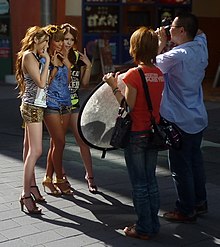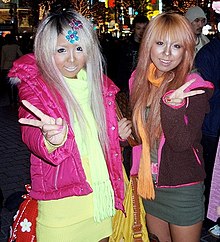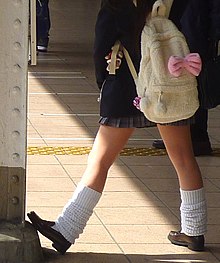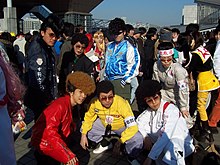Japanese street fashion
There are many styles of street fashion in Japan, created from a mix of both local and foreign labels. Some of these styles are extreme and avant-garde, similar to the haute couture seen on European catwalks. The rise and fall of many of these trends had been chronicled by Shoichi Aoki since 1997 in the fashion magazine Fruits, which was a notable magazine for the promotion of street fashion in Japan.[1]
In 2003, Japanese hip-hop, which had long been present among underground Tokyo's club scene, influenced the mainstream fashion industry.[2] The popularity of the music was so influential that Tokyo's youth imitated their favorite hip hop stars from the way they dress with oversized clothes to tanned skin.[3]
Modern Japanese street fashion
Though the styles have changed over the years, street fashion is still prominent in Tokyo today. Young adults can often be found wearing subculture attire in large urban fashion districts such as Harajuku (Ura-Harajuku), Aoyama, Ginza, Odaiba, Shinjuku and Shibuya.
Lolita

Containing many different themes within its boundaries, Lolita has become one of the larger, more recognizable styles in Japanese street fashion and has gained a following worldwide. Skirts or dresses are usually worn at or below knee length with petticoats beneath for volume. Blouses or tops are lace-trimmed or ruffled in the Victorian or Rococo style. The length of the socks or stockings can go from ankle to thigh level and may be topped with lace. Wearers of this fashion style often put on Mary Janes or boots. The more well-known sub-styles within Lolita fashion are as follows:
- Gothic Lolita - is Lolita with a heavy influence from the Eastern and Victorian Goth style. Often characterized by dark colors, and accessories adorned with motifs such as skeletons, bats, spiders and other popular gothic 'icons', such as characters from Tim Burton films. Victorian iron gates and architectural designs are also often seen in dress prints. Bonnets, rectangle headdresses and brooches are popular accessories for Gothic Lolita.
- Sweet Lolita - is the most childlike style, mostly characterized by baby animals, fairy tale themes and innocent, childlike attire. It was originally inspired by Victorian children's clothing and the kawaii culture that is very prevalent in Japan. Pastel colors are often used, although some dresses or skirts may feature darker or muted colors as well. Large head bows, cute purses and stuffed animals are popular accessories for Sweet Lolita.
- Classic Lolita - The theme of this sub-style is more closely resembled to the historical fashion back in Rococo or Victorian era. The colors that are used in this look are usually muted, thus giving this sub-style a more mature feel. Floral prints and solid colors are common, although fancier prints are not unheard of as well. Small head bows, bonnets, rectangle headdresses and hair corsages are popular accessories for Classic Lolita.
- Punk Lolita - An experimental style, mixing the influences of Punk with Lolita. It can sometimes look deconstructed or crazy, while keeping most of the 'Lolita silhouette'.
- Kodona, a.k.a. 'boy style' and ouji, is a more masculine counterpart of lolita, influenced by Victorian boys' clothing. 'Prince pants', which are short capri-style pants that are cut off the knee, usually with some sort of detail (such as lace-edged cuffs) are commonly worn with masculine blouses, top hats, knee socks etc.[4]
Gyaru

Gyaru, which is sometimes known as ganguro, which is actually a subcategory of gyaru, is a type of Japanese street fashion that originated in the 1970s. Gyaru focuses on girly-glam style, dwelling on man-made beauty (wigs, fake lashes, fake nails etc.). Gyaru is also heavily inspired by Western fashion.
Ganguro

The ganguro style of Japanese street fashion became popular among Japanese girls in the early 1990s and peaked in the early 2000s. Ganguro falls into the larger subculture of gyaru fashion. Ganguro typically includes brightly colored outfits, mini-skirts, and tie-dyed sarongs. The ganguro style consists of bleached hair, a deep tan, fake eyelashes, black and white eyeliner, bracelets, earrings, rings, necklaces and platform shoes.
Many people suppose that Namie Amuro was the leading figure of Ganguro style. Exactly after her public appearances with tanned skin and dyed hair, a lot of Japanese girls started to follow her example. The terms Yamanba and Manba refer to the extremist of the ganguro style. However, Yamanbas and Manbas consider Ganguros as an “easy version” of their style. Nowadays, the name Yamanba has shortened to Manba. [5]
Kogal

The kogal (kogyaru) look is based on a high school uniform, but with a shorter skirt, loose socks, and often dyed hair and a scarf as well. The girls sometimes call themselves gyaru (gals). This style was prominent in the 1990s, but has since declined.
Bōsōzoku

While bōsōzoku fashion has not been popular since the 1990s, the stereotypical bōsōzoku look is often portrayed, and even caricatured, in many forms of Japanese media such as anime, manga and films. The typical bōsōzoku member is often depicted in a uniform consisting of a jumpsuit like those worn by manual laborers or a tokko-fuku (特攻服), a type of military issued over-coat with kanji slogans. These are usually worn open, with no shirt underneath, showing off bandaged torsos and matching baggy pants tucked inside tall boots.
Decora
The Decora style originated in the late 1990s/early 2000s and rose to great popularity both in and outside Japan. It is exemplified by singer Kyary Pamyu Pamyu, who rose to prominence in the Harajuku fashion scene prior to her musical debut. The wearers usually stick to color palettes for their decora; ex. Pink Decora, Red Decora, Dark Decora, and Rainbow Decora. A plain shirt and hoodie was often worn with short tutu-like skirts. The hair (often worn in low ponytails with long bangs) and make-up itself tends to be quite plain. However, the most significant part of decora is to pile on many layers of cute accessories until the bangs and front hair are barely visible. Stockings, legwarmers, armwarmers, and knee socks are also worn over each other in different layers. Common details also include leopard prints and patterned dental masks. The style has since decreased in popularity but still has a large following worldwide.
Kuroi Niji
Kuroi Niji means "Black Rainbow" and the style is a mix between things from the general black scene and rainbow colors. It was introduced by Bou Osaki in 2012.
Visual kei

Visual kei is a style created in the mid-1980s by Japanese musicians consisting of striking makeup, unusual hair styles and flamboyant costumes, similar to Western glam rock and glam metal. Androgyny is also a popular aspect of the style. Some of the more well-known and influential artists of the style include X Japan, Luna Sea, Versailles, The Gazette, Mejibray, Royz, L'Arc en Ciel, An Cafe, Malice Mizer, and Diaura.
Oshare kei
Oshare kei is a version of Visual kei and is seen as the most fashionable and cutting edge of the styles[citation needed]. The style focuses a lot on mixing different patterns, bright colors and punk elements to create a unique look. Unlike Visual kei, the make-up is toned down a bit and focuses more on the eyes alone. Facial piercings are also common. Just like Visual kei, Oshare kei has been largely influenced by musical artists. Some of those include An Cafe, Panic Channel, Ichigo69, Lolita23q, SuG, Delacroix, LM.C, and Aicle.
Angura kei
Angura kei is the darkest visual kei style. The clothes of the style tend to be mostly black, but with spikes and chains. Make-up is worn dark and heavy. The style has been compared to the modern goth. Like the other two styles mentioned, Angura kei is heavily influenced by underground music with the same name. Some of the most well-known ones include MUCC, Floppy, Guniw Tools, Metronome and Nookicky.
Cult party kei
Cult party kei, named after the Harajuku shop Cult Party (now known as the Virgin Mary), is a relatively new coined style that is based on Western religious artifacts like crosses or bibles. Common aspects include crosses wired in yarn, layers of fabric in soft colors, lots of cream lace, satin bows and bible prints. The make-up and hairstyle is not as over the top as other styles. In fact, Cult party kei is often worn with natural looking make-up without any larger emphasis on the eyes and simple hair-dos with roses. Cult party kei is considered by some to be a subset of dolly kei.
Dolly kei
Dolly kei is a style based on Japan's view of the Middle Ages and European fairy tales, especially the Brothers Grimm and Hans Christian Andersen. It includes a lot of vintage-style clothing and sometimes has religious symbols. Grimoire is a store in Japan that has been described as 'the pioneering store behind the Dolly-kei fashion scene'.[6]
Fairy kei
A childlike style, based on 1980s fashion. Outfits are made up of pastel colors (like lavender, baby blue, light pink, mint green, pale yellow, etc.), angel, toy and generally cute motifs and elements and accessories from Western toy lines of the 1980s and early 1990s, such as Polly Pocket, My Little Pony, Strawberry Shortcake, Rainbow Brite, Popples, Lady Lovely Locks, Barbie, Wuzzles, and Care Bears. Pastel colored hair is common although natural hair is also popular, hair is usually kept simple and decorated with anything cute or pastel; bows are a common theme. The term fairy-kei originated from the magazine called Zipper (despite common belief that it was created by Sayuri Tabuchi [Tavuchi], the owner of Tokyo fashion store Spank! which was the accidental creator of the style).[7]
Mori Kei
Mori (which means forest) fashion uses soft, loosely fitting layers of garments such as floaty dresses and cardigans. It places an emphasis on natural fabrics (cotton, linen, wool) and hand-made or vintage accessories with a nature theme. The color scheme tends to be light and neutral, but patterns such as gingham and florals may also be used. In terms of hairstyles, bangs (often curled) and braids are very popular. The style is similar to dolly kei in that the aim is to create a doll-like appearance, but in a more casual, earthy manner.[8]
Kimono style
Japanese fashion is influenced by historic culture; we can now still see Japanese people wearing kimono on the street in Japan, especially in Ginza. In addition, they now still keep the culture of wearing kimono for special and important events, such as graduations, weddings, etc. The younger generation in Japan do also accept mixing kimono and modern style in fashion. They usually mix and match their own style to kimono, like wearing designers bags instead of traditional basket, wearing high heels instead of clogs. There are even modern designers having collections to be inspired, such as "TANZEN" from ISSEY MIYAKE.
Fashion industry and popular brands

Although Japanese street fashion is known for its mix-match of different styles and genres, and there is no single sought-after brand that can consistently appeal to all fashion groups, the huge demand created by the fashion-conscious population is fed and supported by Japan's vibrant fashion industry. Issey Miyake, Yohji Yamamoto and Comme des Garçons are often said to be the three cornerstone brands of Japanese fashion. Together they were particularly recognized as a Japanese fashion force in the early 1980s for their intensive use of monochrome color and cutting-edge design.
As early as the 1950s, there were a few brands specially catered to street fashion, like Onitsuka Tiger (now known as the ASICS).
Japan is also known for its significant consumption of foreign luxury brands. According to data from 2006, Japan consumed 41 percent of the entire world's luxury goods.[9] The blue line of Burberry is among the most successful in this arena.
International influence
Japanese street fashion influences the West Coast of the United States.[10] High-end fashion brands like Comme des Garçons have played a big role in the global industry since the 80s, especially through frequent cross-over guest design with other brands. In 2008, Rei Kawakubo designed for Louis Vuitton[11] and H&M.[12]
Tomoko Yamanaka's work was featured at London Fashion Week, 2010.[13]
Social motives
The motives driving the pursuit of fashion in Japan are complex. Firstly, the relatively large disposable income available to Japanese youth is significant. Many argue this was made possible through youth living at home with their parents, reducing living expenses.[14] In addition, the emergence of a strong youth culture in the 1960s and 1970s that continues today (especially in the Harajuku district) drives much of the striving for new and different looks. The rise of consumerism to an important part of the "national character" of Japan during the economic boom of the 1980s, and even after the bubble burst consumerism also contributes to the pursuit of fashion. These factors result in swift turnover and variability in styles popular at any one time.[15]
See also
References
- ^ "Fruits: future-pop fashion". Dazed. 2016-01-12. Retrieved 2019-07-28.
- ^ Takatsuki, Yo (2003-12-17). "Japan grows its own hip-hop". BBC News.
- ^ Condry, Ian. Hip-hop Japan: Rap and the Paths of Cultural Globalization. Durham, NC: Duke University Press, 2006.
- ^ "Kodona". Archived from the original on 2012-03-17.
- ^ DIGIMBAYEVA, ANELIYA (August 3, 2018). "Japanese Street Fashion". STREETWEARCHICK. Retrieved April 9, 2020.
- ^ "Grimoire Shibuya - Japanese Dolly-kei & Vintage Fashion Wonderland". Tokyofashion.com. 2010-03-13. Retrieved 2011-12-11.
- ^ McInnes, Paul. "Spank! – Japanese "80s Pop Disco" Fashion in Tokyo". tokyofashion.com. tokyofashion.com. Retrieved 28 March 2012.
- ^ SHOJI, KAORI (February 8, 2010). "Cult of the Living Doll in Tokyo". NY Times. Retrieved March 30, 2012.
- ^ Japan External Trade Organization| Japan is the world's most concentrated source of revenue for luxury brands Archived 2009-03-02 at the Wayback Machine
- ^ http://liftmeupwardrobe.co.uk/2013/07/19/fashion-sensei/
- ^ http://www.style.com/stylefile/2008/08/rei-kawakubo-puts-her-stamp-on-louis-vuitton/
- ^ http://www.vogue.co.uk/news/2008/04/03/comme-des-garcons-for-handm
- ^ "Designer profile : Cabinet by Tomoko Yamanaka". London Fashion Week. 2011-09-21. Retrieved 2011-12-11.
- ^ Letter from Tokyo: Shopping Rebellion – What the kids want
- ^ Godoy, Tiffany (December 2007). Vartanian, Ivan (ed.). Style Deficit Disorder: Harajuku Street Fashion Tokyo. San Francisco: Chronicle Books LLC. ISBN 9780811857963. Retrieved 14 March 2018.

